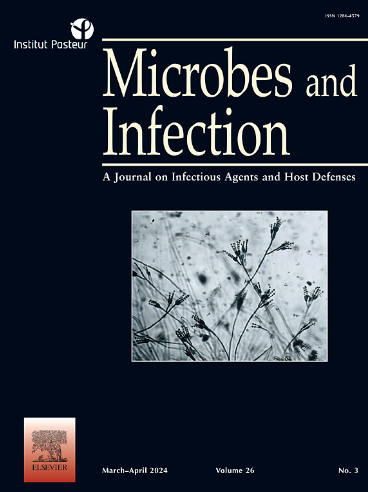Proteolytic activity of secreted proteases from pathogenic leptospires and effects on phagocytosis by murine macrophages
IF 2.7
4区 医学
Q3 IMMUNOLOGY
引用次数: 0
Abstract
Leptospirosis is a zoonosis caused by spirochete Leptospira. Pathogenic leptospires evade the Complement System, enabling their survival upon contact with normal human serum in vitro. In a previous study, we demonstrated that proteases secreted by pathogenic leptospires cleave several Complement proteins, including C3 and the opsonins C3b and iC3b. We hypothesize that these Leptospira proteases, such as thermolysin and leptolysin, may decrease the phagocytic activity of murine peritoneal macrophages. We observed decreased amounts of CR3 and CR4 using flow cytometry when these cells were treated with supernatant from the culture of pathogenic leptospires (SPL) for 24 h. Through confocal microscopy, we observed a reduction in TLR2, CD11b, and CD206 (mannose receptor) levels when these cells were treated with SPL or recombinant thermolysin for 24 h. Furthermore, opsonins such as C3b/iC3b deposited on the surface of pathogenic leptospires were clearly degraded in the presence of recombinant thermolysin or recombinant leptolysin. Consequently, when opsonized bacteria and macrophages were previously incubated with these proteases, phagocytic activity was diminished. These observations lead us to suggest that proteases secreted by pathogenic leptospires could degrade opsonins present in normal serum or deposited on the bacterial membrane, as well as cleave or inhibit macrophage surface molecules. Therefore, these proteases could interfere with the recognition and internalization by murine macrophages, favoring the spread of leptospires in the host.

致病性钩端螺旋体分泌蛋白酶的蛋白水解活性及其对小鼠巨噬细胞吞噬的影响。
钩端螺旋体病是一种由钩端螺旋体引起的人畜共患病。致病性钩体逃避补体系统,使其在体外与正常人血清接触后存活。在之前的一项研究中,我们证实病原钩端螺旋体分泌的蛋白酶可以切割几种补体蛋白,包括C3和调理素C3b和iC3b。我们假设这些钩端螺旋体蛋白酶,如热溶素和瘦溶素,可能会降低小鼠腹膜巨噬细胞的吞噬活性。我们用致病性钩端螺旋体(SPL)培养的上清液处理这些细胞24小时后,流式细胞术观察到CR3和CR4的含量降低。通过共聚焦显微镜,我们观察到当这些细胞用SPL或重组热溶素处理24小时时,TLR2、CD11b和CD206(甘露糖受体)水平降低。此外,沉积在致病性钩体表面的调理素如C3b/iC3b在重组热溶素或重组瘦溶素存在下被明显降解。因此,当调理细菌和巨噬细胞先前与这些蛋白酶孵育时,吞噬活性降低。这些观察结果使我们认为病原钩端螺旋体分泌的蛋白酶可以降解存在于正常血清或沉积在细菌膜上的调理素,并裂解或抑制巨噬细胞表面分子。因此,这些蛋白酶可能干扰小鼠巨噬细胞的识别和内化,有利于钩体在宿主中的传播。
本文章由计算机程序翻译,如有差异,请以英文原文为准。
求助全文
约1分钟内获得全文
求助全文
来源期刊

Microbes and Infection
医学-病毒学
CiteScore
12.60
自引率
1.70%
发文量
90
审稿时长
40 days
期刊介绍:
Microbes and Infection publishes 10 peer-reviewed issues per year in all fields of infection and immunity, covering the different levels of host-microbe interactions, and in particular:
the molecular biology and cell biology of the crosstalk between hosts (human and model organisms) and microbes (viruses, bacteria, parasites and fungi), including molecular virulence and evasion mechanisms.
the immune response to infection, including pathogenesis and host susceptibility.
emerging human infectious diseases.
systems immunology.
molecular epidemiology/genetics of host pathogen interactions.
microbiota and host "interactions".
vaccine development, including novel strategies and adjuvants.
Clinical studies, accounts of clinical trials and biomarker studies in infectious diseases are within the scope of the journal.
Microbes and Infection publishes articles on human pathogens or pathogens of model systems. However, articles on other microbes can be published if they contribute to our understanding of basic mechanisms of host-pathogen interactions. Purely descriptive and preliminary studies are discouraged.
 求助内容:
求助内容: 应助结果提醒方式:
应助结果提醒方式:


